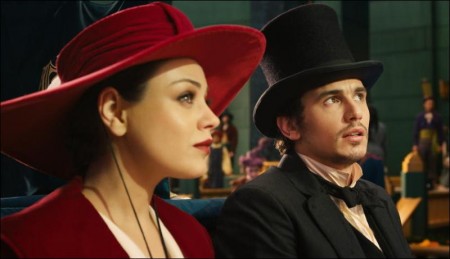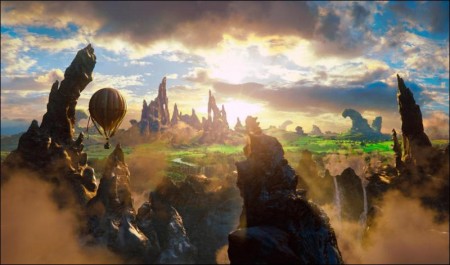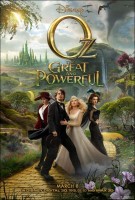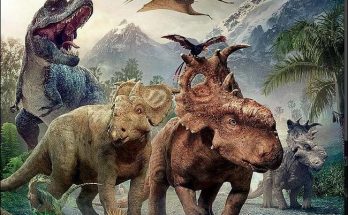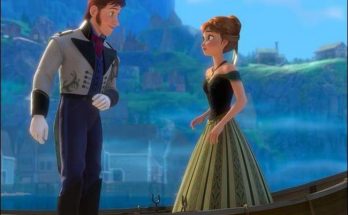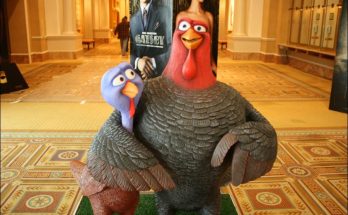Taglines: Find yourselif in Oz.
Walt Disney Pictures’ fantastical adventure Oz The Great and Powerful, directed by Sam Raimi, imagines the origins of L. Frank Baum’s beloved character, the Wizard of Oz. When Oscar Diggs (James Franco), a small-time circus magician with dubious ethics, is hurled away from dusty Kansas to the vibrant Land of Oz, he thinks he’s hit the jackpot — fame and fortune are his for the taking — that is until he meets three witches, Theodora (Mila Kunis), Evanora (Rachel Weisz) and Glinda (Michelle Williams), who are not convinced he is the great wizard everyone’s been expecting.
Reluctantly drawn into the epic problems facing the Land of Oz and its inhabitants, Oscar must find out who is good and who is evil before it is too late. Putting his magical arts to use through illusion, ingenuity — and even a bit of wizardry — Oscar transforms himself not only into the great and powerful Wizard of Oz but into a better man as well.
The Story (2013)
“This is a story of how the wizard came to be the wizard; of how a smalltime carnival magician — a faker, a charlatan — came to a fantastic world and was just the thing that they needed to save the day. It’s the tale of how an average man who was selfish became a great wizard who is selfless.” — Sam Raimi, director
L. Frank Baum, who wrote 14 novels between 1900-1920, all set in the Land of Oz he so vividly created, never fully portrayed the wizard character’s background in any of his books. Producer Joe Roth found that fact fascinating. “I love origin stories and I liked the idea of how the wizard came to be,” says Roth. “So, going back to Baum’s books to research and imagine his beginnings seemed like a great idea.”
“L. Frank Baum wrote a series of adventures with multiple characters in Oz,” states Raimi’s longtime producing partner, Grant Curtis. “I think the beauty of what Mitchell Kapner originally did, along with producer Joe Roth and executive producer Palak Patel, was that they took some of the adventures throughout these books and brought them together into one concise story that depicts how Oz became the great wizard.”
Mitchell Kapner and David Lindsay-Abaire’s imaginative screenplay follows Oscar Diggs, a small-time circus magician with dubious ethics, who is hurled away from dusty Kansas to the vibrant Land of Oz. There, Oscar thinks he’s hit the jackpot — fame and fortune are his for the taking — that is until he meets three witches, Theodora, Evanora and Glinda, who are not convinced he is the great wizard everyone’s been expecting. Reluctantly drawn into the epic problems facing the Land of Oz and its inhabitants, Oscar must find out who is good and who is evil before it is too late. Putting his magical arts to use, along with some ingenuity — and even a bit of wizardry — Oscar transforms himself not only into the great wizard but into a better man as well.
“It begins with a circus con artist who gets caught up in a tornado in a hot-air balloon and lands in this magical Land of Oz,” screenwriter Mitchell Kapner elaborates about the original story inspired by the works of author L. Frank Baum. “Because his name is Oz, his arrival coincides with a prophecy that states that a new and great leader is forthcoming. Because the Wicked Witch has taken over the land, the people look to this stranger as this great Wizard. They bow down to this mere mortal when they see his name on the side of his balloon.
“This is a guy, bluffing his way through life because he doesn’t have real magic powers like these witches do, who can become their leader and get Emerald City back from the Wicked Witch,” the screenwriter resumes about the story. “I liked the dynamic that people expected him to be this powerful wizard, which he knows he’s not. Yet, he can claim this throne, and essentially be the King, if he convinces enough people. Along the way, he realizes it’s not just about him. He has to do it to save these people.”
“What I love most about this character of Oz is that he is such a dastardly heel,” says co-screenwriter David Lindsay-Abaire about the film’s unlikely hero. “But, he also craves something greater, both from his life and for himself as a person. He wants to do great things, and, in the beginning, it’s only about money and power and riches. By the end of the story, he finds out it’s actually about finding love and friendship. It’s a very human story.”
Before Lindsay-Abaire joined the project, Roth sought a director to bring Kapner’s story to life before the cameras. In choosing the acclaimed Sam Raimi, no stranger to Hollywood’s arena of epic film works (the “Spider-Man” trilogy), the veteran producer and former studio executive found what he felt was the best of a small fraternity of seasoned filmmakers who could bring the necessary scope to Kapner’s script.
“In tackling the Oz story, I could think of no better director than Sam Raimi,” says the filmmaker. “Sam is one of our leading directors who has great heart as well as visual artistry. Everything makes him the right director, frankly. He’s worked on films of this size and scope. He’s worked in a world of special effects and live action combined. And more than anything, he has the heart and the sensibility of the story.”
When Raimi read the script for “Oz The Great and Powerful,” he “fell in love with it.” He says, “I thought it was engaging and that it had a great, flawed main character. His adventure was fun and, eventually, his character’s transformation gave it an uplifting quality that I really enjoyed.”
Working in 3D
“When I came on the film, the first draft of the screenplay already existed and I heard that producer Joe Roth and the Walt Disney Studios wanted to make the film in 3D,” Sam Raimi explains about his very first foray in the digital 3D realm. “I thought it was a good idea. I think that for this project, the fact that it introduces the audience to Baum’s fantastical world and can give them a sense of dimensionality, a sense of space, is very exciting.”
Not only did the project mark Raimi’s first in digital 3D, but also that for his cinematographer, another longtime ally, Peter Deming (“Drag Me to Hell,” “Evil Dead II”), who remarks that “3D is definitely a different animal. You’re working at different light levels. Your choice of lenses is much different than for a 2D film. You’re always looking for new ways to cover your scenes or maximize the 3D in the blocking and the staging, as opposed to a 2D movie.
“In taking on the project, Sam was faced with two new ventures, 3D and digital,” Deming continues. “We talked a lot about that, about what cameras to use, about shooting in 2D and converting in post-production, a practice called dimensionalization. Shooting on film and converting to digital. We probably spent a month prepping and shooting tests in Los Angeles on two different 3D systems, two different cameras, and film. And then posting all that through 2D or 3D imaging and comparing them all.
“The camera we ultimately settled on was the Red Epic because in 3D, much like your eyesight, you need two images to make a three-dimensional fact,” the veteran cinematographer explains about the 3D camera process. “Our eyes are fairly close together and there’s no way to get two cameras that close together. So, you end up with a 50 percent mirror and you have one camera conventional and one on top so they’re looking through the same mirror at the same subject.
“Yet, the center of each image is only about an inch apart, and you can vary that distance between the center to create various 3D effects. So, it ends up being quite a large structure compared to a normal motion picture camera. We obviously wanted the highest quality camera, but as compact as we could get without giving up quality. And that’s what the Epic gave us,” the camera veteran concludes.
“Our story begins in Kansas in the year 1905. It’s presented in black and white. The 3D is dialed down. The soundtrack will be mono. When we get to the Land of Oz, the screen opens up to a widescreen format,” Raimi explains about the opening 18 minutes of the film. “We’ll transition from mono into the full 7.1 sound, bring the choir up on the track, go to full color and dial up the 3D. And I hope that together these effects will be a powerful experience for the audience.”
“And, while we shot the entire film in 3D, we shot it at a very shallow depth for these opening scenes,” Deming adds. “When we get to Oz, we transition from black and white to color. We also go from 1:66 to 2:40 widescreen and we expand the 3D.”
Oz: The Great and Powerful (2013)
Directed by: Sam Raimi
Starring: Mila Kunis, Rachel Weisz, James Franco, Michelle Williams, Zach Braff, Abigail Spencer
Screenplay by: L. Frank Baum, Mitchell Kapner, David Lindsay-Abaire
Production Design by: Robert Stromberg
Cinematography by: Peter Deming
Film Editing by: Bob Murawski
Costume Design by: Gary Jones
Set Decoration by: Nancy Haigh
Music by: Danny Elfman
MPAA Rating: PG for sequences of action and scary images, and brief mild language.
Studio: Walt Disney Pictures
Release Date: March 8, 2013
Visits: 44

